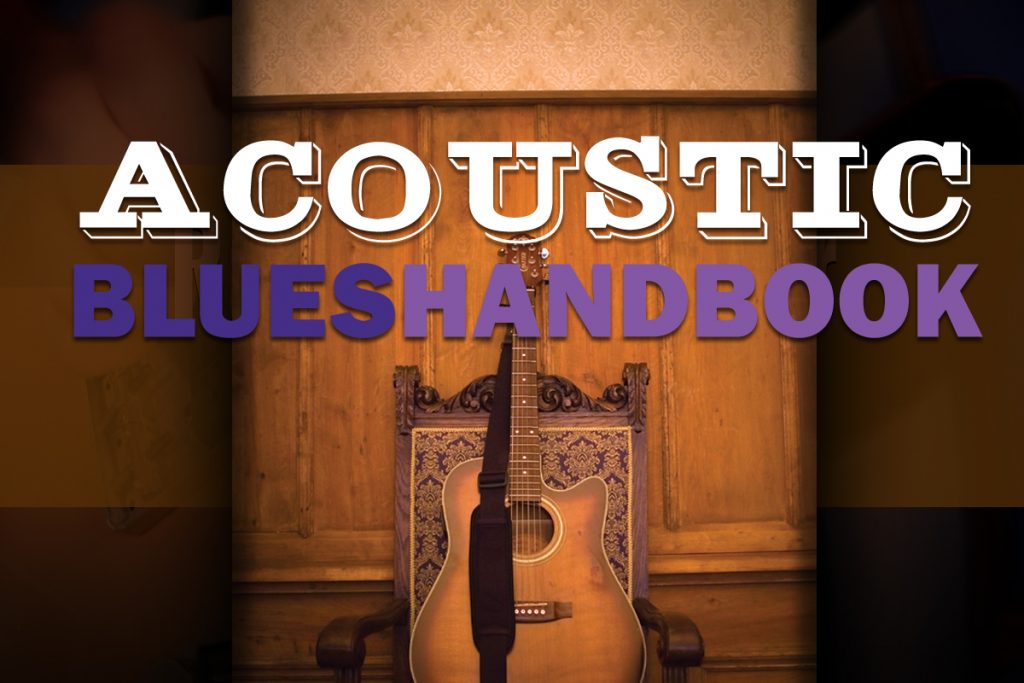These 7 free guitar lessons are from Joe Dalton’s Acoustic Blues Handbook, a series of guitar lessons designed to give the late beginner and early intermediate student a complete range of rhythms, turnarounds, solos, scales, and “guitaristic” tricks to plug in to any 12 bar blues progression.
“The Acoustic Blues Handbook equips the student with all of the tools necessary to create and play their own solo blues tunes. This guitar lesson approach is modular in nature. Students learn a series of “plug-ins” including rhythm patterns, turnarounds, stop-time solos, constant bass solos, walking bass lines, fills, intros, endings and more. After getting a grip of these bite-size parts, they learn how to put them together to form entire blues arrangements.”
Acoustic Blues Handbook: Early Rock n’ Roll
Download the tab & notation for this (title).
One of the challenges of writing a lesson is finding the spot of common ground. Where is that spot where most of us are comfortable and we can begin to build? In this instance, I thought this simple rhythm would be that great place to start. Most of us have played this rhythm many times.
Spend some time getting the shuffle rhythm to sound just right. If you are new to this rhythm, work on it slowly, then take it slightly faster until you just feel the rhythm. Spend some time listening to some shuffles, electric or acoustic.
Acoustic Blues Handbook: New Rhythm Pattern
Download the tab & notation for this acoustic blues lesson.
This new rhythm pattern gives the whole chorus a laid back feel. By splitting the notes, we take away some of the drive and leave us just rolling along. The pick-up note rhythm comes from the previous measure. So, after we count 4 beats, we play the pick-up note before then first beat of the measure. (or in other words between the 4 and the 1) After you get the shuffle feel and the new pattern, you can add the flatted 7th to the pattern.
Acoustic Blues Handbook: A Third Embellishment
Download the tab & notation for this acoustic blues lesson.
Now, this chorus sounds busy. It also sounds like there is a lot going on. This is a great way to impress your guitar playing friends, and we built it from the Chuck Berry style rhythm. One of the ways to get away with a busy sounding part is to repeat it. The listener gets used to the pattern through the repetition. Have fun with this. As always, I can’t stress it enough, practice this slowly and meticulously. This will pay off in less time if you practice properly.
Acoustic Blues Handbook: Combining what We Know Into an Arrangement
Download the tab & notation for this acoustic blues lesson.
This is exciting. After you learn this arrangement, try another of your own. Notice how the thing builds. There should be a climax. Each plug in is a statement of its own. The rolling feel of the rhythm sets a tone. The turnaround sets us up for another time through. The fill adds just the right melodic sense to bring the whole thing together. The most important lesson here is to listen to what you are playing.
Acoustic Blues Handbook: Changing the Progression
Download the tab & notation for this acoustic blues lesson.
There are many different blues progressions. Listen to Stormy Monday, Summertime, God Bless the Child. There are many. We are not looking at those progressions here. What we have here are some simpler variations on the basic 12 bar blues progression. You will find that the “new” chords lead into the next chord. This first change is a simple one that adds life right at the beginning of the chorus. Moving right to the IV chord adds a rocking feeling, a back and forth movement.
Acoustic Blues Handbook: Blues in A
Download the tab & notation for this acoustic blues lesson.
All we need to play blues in the key of A is a D7 pattern. And, as with the other patterns we’ve learned, it’s very easy to find because we’ve used these chords many times. Your homework is to transpose all of the other ideas from the key of E to the key of A. This will keep you busy and out of trouble. I believe in pointing you in a direction instead of spoon feeding. There is a proverb that says: “Give someone a fish and you feed him for a day; teach someone to fish and you feed him for a lifetime.” Enough said.
Acoustic Blues Handbook: Putting It All Together
Download the tab & notation for this acoustic blues lesson.
There is no tab or notation for this example. I’ve been saying you need to listen, so here it is. You have played everything here. I’ve taught you everything you need to know to play like this. Now go and make your own. I’m going to refer to the proverb again: “Give someone a fish and you feed him for a day; teach someone to fish and you feed him for a lifetime.”
Dig these Acoustic Blues lessons? Download Joe Dalton’s Acoustic Blues Handbook for much more including tab, notation, and jam tracks!

